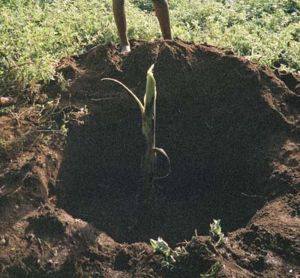
The banana is one of mankind's most prized foods. The banana is generally is produced in the tropics and subtropics from plants of the genus Musa W.
There is no such thing as a 'banana tree'. The plant is an herb very similar in structure to the onion. It has absolutely no wood. It is its size that leads people of the temperate zone to call it a 'tree'. The tallest of the banana varieties can reach 12 to 15 meters (40 to 50 feet) tall. There are over 300 named varieties of this fruit but only a dozen are well known in the Americas.
Popularly, this fruit is divided into two types, the sweet eating type banana and the starchy cooking type, the plantain. Most banana fruit sold in temperate zones are of the Cavendish or Valery varieties, are fairly large with a fairly good shelf life. These varieties, however, relatively lack flavor as compared to the more popular varieties in the tropics.
All eatable bananas are genetically naturally occurring triploids and thus produce no seeds. Diploid bananas produce fruit that is up 80% full of large, hard seeds, and, although the remaining flesh is quite eatable, there's just not enough of it. Mutants of the cooking banana are often used to make banana beer in East Africa, a very popular drink. A seeded banana called abacáW or abaca is the source of the commercial fiber, Manila hempW (not to be confused with true hemp).
Banana Management[edit | edit source]

See Better Farming Series 18 Bananas gives an in depth details on managing bananas. Additional info is added to this below
Site Selection[edit | edit source]
- Avoid big trees - Dead roots can harbour a ArmillariaW fungus that leads to Armillaria root rot which is very difficult to eradicate (aka Honey fungusW)
- Eliminate perenial and bad weeds before introducing bananas especially Couch grassW. Constant weeding and ploughing can keep weeds to minimum
Preperation & Treatment of Planting Materials[edit | edit source]
- Assesing suitability of suckers - Younger suckers are less likely to be affected by diseases
- Pare (with knife) - Removing all roots and get rid of any unhealthy looking parts of the root, they may contain nematodes or weevils.
- Treatment - To reduce risk of nemetoads and weevils in suckers, treatment before planting
- Immerse sucker in water 60-65 degrees (hot water but doesn't burn) for 10 minutes. This burns any fungus or eggs
- OR, Immerse in cold water for 2 days. This suffocates fungus or eggs
- Neem seed extracts can also be used
Intercropping[edit | edit source]
- Intercroping with beans in the first season after planting ensures full exploitation of the soil and provides good soil cover
Windbreaks[edit | edit source]
Banana plants are often destroyed in windy conditions. Wind breaks can reduce the risk of this
- Planting wind breaks along the perimeter (10m apert)
- Within the plantation (20m x 20m)
- Examples of wind breaks: Grevillea robustaW, Gliricidia sepium, Maesopsis emim, Calliandria, PawpawW, MangoW, JackfruitW, LoquatW
See also[edit | edit source]
- The Use of Organic Residues in Rural Communities, Chapter 9
- Better Farming Series 18 Bananas (FAO - INADES, 1977, 27 p.)